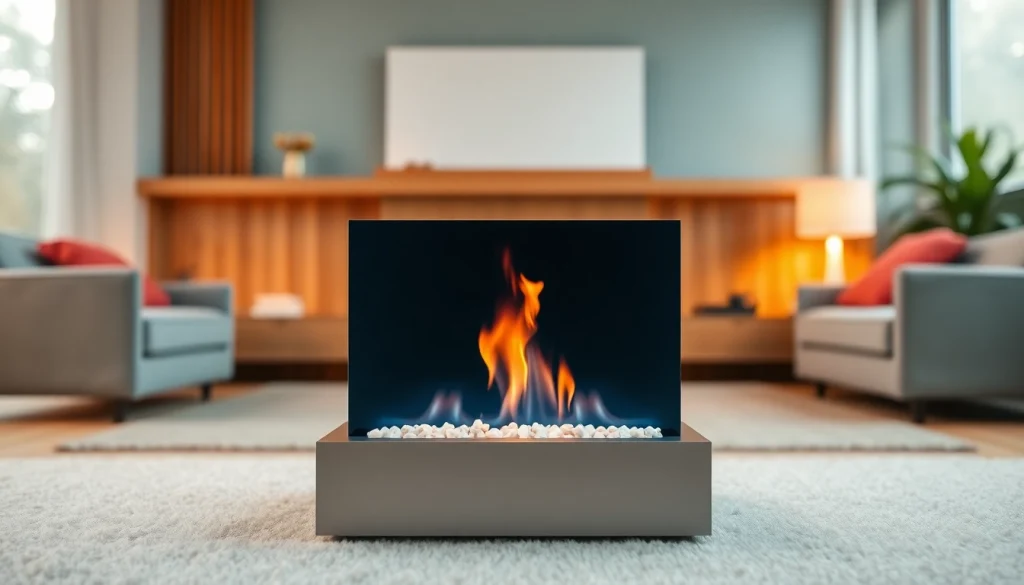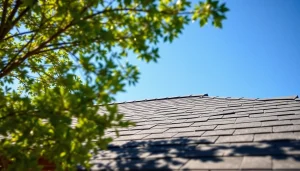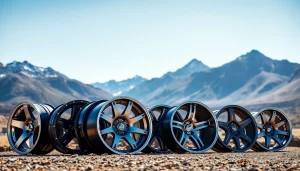Enhance Your Living Space with a Stylish Water Vapor Fireplace

Introduction to Water Vapor Fireplaces
A water vapor fireplace is a cutting-edge innovation in home heating that merges technology with aesthetics. Traditionally, fireplaces have been associated with crackling flames and smoke, conjuring images of cozy winter evenings. However, water vapor fireplaces have emerged as a modern alternative, offering the visual appeal of a flame without the safety concerns associated with traditional fire features. In this article, we delve deep into the workings, benefits, types, installation, and much more regarding water vapor fireplaces, providing insights that will help potential buyers make informed decisions.
What is a Water Vapor Fireplace?
A water vapor fireplace is an electric fireplace that creates realistic flame effects using advanced ultrasonic technology. These units are designed to mimic the appearance of a traditional fireplace while providing a safer and maintenance-friendly environment. Unlike conventional models that burn wood or gas, water vapor fireplaces rely on distilled water to produce a fine mist. This mist, when lit by LED lights, creates a stunning 3D illusion of fire, providing the ambiance of a real flame without the heat. The result is a mesmerizing visual display that enhances any living space, from modern lofts to cozy cottages.
How It Works: Technology Behind the Flame Illusion
The technology utilized in water vapor fireplaces primarily involves an ultrasonic transducer that emits high-frequency vibrations. These vibrations break water molecules into tiny droplets, forming a mist that rises from the reservoir. Once created, this mist interacts with LED lights, which shine through the droplets, creating a flickering flame effect. This method is both energy-efficient and environmentally friendly, as it doesn’t produce harmful emissions, making it suitable for indoor use. Additionally, most models feature adjustable settings, allowing users to control the intensity of the flames and the water vapor settings to fit different moods or occasions.
Benefits of Choosing Water Vapor Over Traditional Fireplaces
Choosing a water vapor fireplace offers numerous advantages over traditional wood-burning or gas fireplaces. Here are some notable benefits:
- Safety: Water vapor fireplaces do not produce real flames or combustion gases, making them safe for homes with children and pets.
- Energy Efficiency: These units consume significantly less energy and often include features that make them easy to operate, including remote controls and timers.
- No Smoke or Ash: Since there’s no combustion, these fireplaces do not emit smoke, nor do they leave behind soot and ash, which require regular cleaning.
- Humidity Control: Water vapor fireplaces add moisture to the air, which can create a more comfortable indoor environment, especially during dry winter months.
- Aesthetic Flexibility: They come in various styles and designs, from sleek and modern to more traditional looks, easily fitting into any home décor.
Benefits of Water Vapor Fireplaces
Eco-Friendly Features and Safety Benefits
Water vapor fireplaces are a prime solution for eco-conscious homeowners. By utilizing water as a fuel source, they do not contribute to air pollution, thus promoting healthier indoor air quality. Furthermore, many modern models also incorporate LED lighting, which uses far less energy than conventional incandescent bulbs. This innovative approach aligns with sustainable living practices, offering a contemporary way to achieve comfort and warmth without compromising the environment.
Maintenance and Care: What to Expect
Maintenance for water vapor fireplaces is straightforward, making them an attractive option compared to traditional fireplaces. Users generally need to refill the water reservoir and clean the mist dispersion outlet occasionally. Depending on usage, water tanks typically need refilling every few days to weeks. It’s advisable to use distilled water to avoid mineral buildup, which can affect performance. Most manufacturers recommend cleaning every two weeks for optimal functionality.
Cost Analysis: Initial Investment vs. Long-Term Savings
When considering a water vapor fireplace, initial costs can vary significantly depending on the model and installation requirements. Prices typically range from a few hundred to several thousand dollars for premium units. However, it’s essential to view this as a long-term investment. Water vapor fireplaces can reduce energy bills due to their efficient operation and often qualify for eco-friendly rebates or incentives. Furthermore, their low maintenance and cleanup costs, coupled with the absence of wood or gas supplies, make them a financially savvy choice in the long run.
Types of Water Vapor Fireplaces
Standalone vs. Insert Models
Water vapor fireplaces can be broadly categorized into standalone and insert models. Standalone fireplaces are freestanding units that can be placed anywhere in a room, providing flexibility in terms of interior design. These models are ideal for renters or those who want a temporary solution without permanent installation. On the other hand, insert models are designed to be integrated into the existing fireplace structure or custom-built settings. This option is perfect for homeowners looking to upgrade older units without a complete remodel, offering advanced technology along with a classic look.
Size and Design Options for Every Space
With varying sizes and designs available in the market, there’s a water vapor fireplace suitable for any space, from small apartments to expansive living rooms. Sizes typically range from compact units perfect for corner nooks to larger, feature fireplace installations that can become the room’s centerpiece. Customization options, such as mantels and frames, further enhance adaptability, allowing for integration that complements existing design elements.
Popular Brands and Models on the Market
Several brands lead the water vapor fireplace market, each offering unique features that cater to different consumer needs. Brands like Aquafire, Dimplex, and Modern Blaze have gained popularity with models known for their advanced technology and aesthetic appeal. For example, the Aquafire® series boasts cool-to-the-touch flames while providing safe heating solutions, while Dimplex’s models are recognized for realistic flame effects and energy efficiency. Buyer reviews and expert recommendations can help consumers navigate which brand and model best suit their requirements and budget.
Installation and Setup
Step-by-Step Installation Guide
Installing a water vapor fireplace can be a straightforward process, especially with pre-assembled models. Here’s a general step-by-step guide to help with installation:
- Select the Location: Choose a flat and stable surface that allows access to electricity and water supply.
- Position the Unit: Move the unit into place, ensuring it is level and secure.
- Connect to Water Supply: For models requiring a direct water line, connect to the water supply following the manufacturer’s specifications. For standalone models, simply fill the reservoir manually.
- Connect Power Source: Plug the fireplace into a nearby outlet. Ensure that the outlet is rated to handle the unit’s electrical load.
- Test Functionality: Once installed, turn on the unit to test the fog production and lighting effects, ensuring everything operates as expected.
Common Installation Mistakes to Avoid
While installing a water vapor fireplace is typically easy, some common mistakes can be avoided for a seamless setup:
- Ignoring Manufacturer Guidelines: Always refer to the manufacturer’s installation instructions to avoid misconfiguration.
- Improper Positioning: Avoid placing the fireplace in drafty or excessively humid areas to ensure optimal performance.
- Electrical Load Management: Ensure that the power source meets the fireplace’s requirements to prevent potential electrical issues.
Connecting to Water Supply: How It Works
Connecting a water vapor fireplace to a water supply can provide continuous operation, minimizing user maintenance. For installations that require this setup, a standard plumbing connection is typically made to the back of the unit. Some models may require professional installation to ensure compliance with local plumbing codes, while others are designed for do-it-yourself setups. Ensure all fittings are secure to prevent leaks and maintain system integrity for optimal function.
Frequently Asked Questions
Are Water Vapor Fireplaces Worth It?
The worth of a water vapor fireplace often depends on user preferences and needs. For those seeking a visual enhancement rather than a primary heat source, these fireplaces offer unique benefits, including safety, environmental consciousness, and aesthetic appeal. Customers who wish for year-round ambiance without the heating costs associated with conventional fireplaces usually find them a worthy investment.
Common Issues and Troubleshooting Tips
While water vapor fireplaces are generally reliable, users may encounter a few common issues, such as:
- Insufficient Fog Production: Ensure the water reservoir is full and appropriately filled with distilled water to enable optimal mist production.
- Lighting Malfunctions: If the flames appear dim or nonexistent, check the LED bulbs for any burnt-out components and replace them as necessary.
- Unexpected Shutdown: If the unit shuts off unexpectedly, ensure that the water pump is functioning correctly and there are no obstructions.
Future Trends in Water Vapor Fireplace Technology
The future of water vapor fireplaces looks promising, with advancements in technology leading to more innovative features and functionalities. Upcoming trends include enhanced interactive smart technology, integrating voice control and app connectivity to adjust settings remotely. Companies are also exploring improved energy recovery systems, allowing units to recycle humidity from the environment and maximize efficiency. Additionally, aesthetic enhancements are expected, including greater flame realism and customizable ambiance settings to enhance user experience further.







